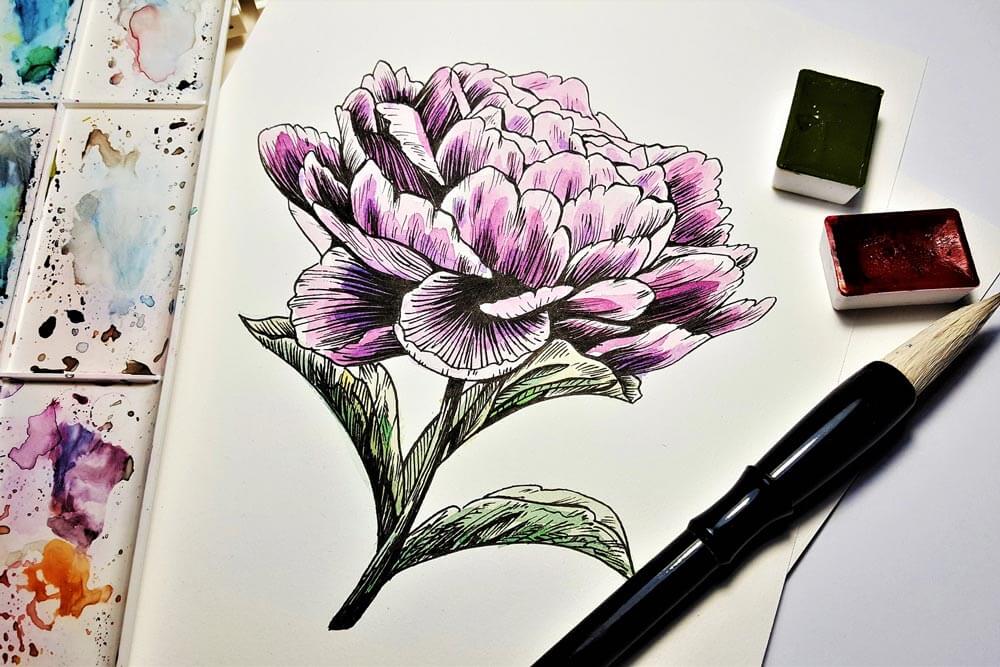When it comes down to defining the real differences between ink and paint, its largely up to the company’s discretion.
However, with that being said, ink and paint do carry certain characteristics.
While there are several edge cases where a paint may be used as an ink and vice versa, we are only going to stick to the very general classifications for the scope of today’s article.
Therefore, we don’t want our lovely readers to always hold the information below with absolute conviction (you will see why in just a minute).

Table of Contents
General Characteristics And Uses of Ink
Ink is a solution that is found in many printmakers workshops and the primary solution found in pens.
Ink is typically made up of dyes.
These are pigments that have been dissolved into a solution.
Ink is mostly made for writing, drawing, and general day-to-day applications.
Generally speaking, the flow of ink is considered to be much thinner (akin to water).
This largely has to do with the primary writing instruments that rely on them (i.e. pens).
Whether you use a ballpoint pen or fountain pen, the ink must be thin enough to flow out of the barrel effortlessly.
But what happens if the ink is not thin enough?
Ink that is too thick may clog a ballpoint or nib tip rendering the pen useless.
This is particularly important with ballpoint pens; thicker solutions may require more effort by the user which will then in turn cause hand fatigue during extended writing sessions.
Now with its inks permanence property:
While inks are designed to penetrate the surface, they often will diminish when exposed to natural elements and ultraviolet lights. Therefore, if you plan on using ink for a permanent piece that will be on display, its often recommended that a varnish or some sort of protectant is applied for preservation.
While ink largely used in printing presses, pigment based ink (which is more akin in nature to paint), is the primary medium used for silkscreen printing (i.e. graphic t-shirts, hats, bags, etc.).

General Characteristics And Uses Of Paint
Unlike paint where a dye or pigment has been dissolved into a water-like form, paints are formed (generally), a bit differently.
Typically made by adding a pigment (synthetic or natural) to a medium such as gum arabic or linseed oil, paints aren’t necessarily dissolved into a solution.
Instead, these intermediary mediums such as linseed oil help to carry the pigment to a surface.
Rather than trying to penetrate a surface like most inks, paints will rest on top of the surface.
Although, as we all likely are aware, you can’t just simply scrape or peel off a layer of paint from a canvas as much of the pigment will be trapped within the weavings of this particular surface.
When it comes to tools to use paint, typically its always going to be reserved for brushes or palette knives as opposed to pens.
As we eluded to earlier, there are always going to be exceptions to this (i.e. spray paint).
Surfaces For Using Inks And Paints
Given that most inks tend to be much thinner than paint, you will often find yourself reaching for lower lbs (or gsm) paper as the concern for bleeding likely isn’t a large concern.
However, if you plan on liberally applying ink to your next piece of work (i.e. Sumi-E painting anyone?!), you will likely want to go with a surface that is much thicker or rigid (i.e. typically watercolor paper – rated at 300 gsm or higher).
Conversely, most paints like acrylic or oil will often require surfaces that are much more thicker or rigid simply due to the sheer weight of the pigment.
While we just covered acrylic on paper the other day, most paints often present very well on canvas and other natural materials.

Mixed Media Of Paints And Inks
You don’t have to search for long to find artists either at your local gallery or simply on social media showcasing their works that mix both inks and different paints together.
When combined, ink and paint can really create astonishing pieces of work that really take your breath away.
So, if you are considering in dabbling between these two distinct mediums, we would recommend trying it out!
Really, you can develop some terrific pieces.
Closing Thoughts On Ink vs. Paint
While the above is to serve only as some general guidelines, please don’t interpret them as strict rules.
If you are just starting out with painting or drawing, these definitions can at the very least serve as a baseline on what you should consider when selecting art supplies.